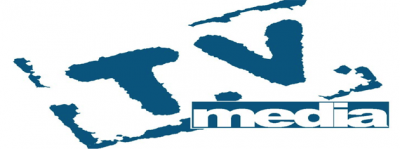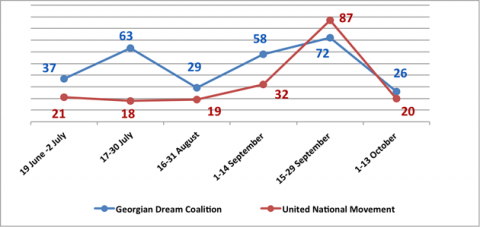I am not addicted to TV but I found myself sitting in front of the TV almost 24 hours a day before the 2012 Georgian parliamentary elections. I considered myself a rational consumer of information, so it was surprising that was unable to resist the temptation to watch a channel presenting quite slanted opinions. My previously apolitical friends were experiencing the same phenomena. This post is reflection of this. How is it that rational consumers of information like me could come to be consciously watching politically slanted news? How and why was the Georgian media polarized? What effect did the elections have on polarization?
Willing to have clear idea what was happening around me, I started to look for all existing literature and proper data to analyse. I have found out that media bias might arise from supply side and from demand side as well. The supply side reasons reflect the preferences of journalists (David Baron, 2004) or owners of media channels aiming to influence their audience (Besley and Andrea Prat, 2004; Simeon Djanjov et al., 2003). As for demand side, consumer preferences are an essential determinant of media bias. This was an interesting discovery for me. I thought of the audience as a “victim” of slanted media, but it turns out that people generally like watching confirmatory news and hearing opinions close to their own.
This thus makes media bias profitable. Posner (2005) summarizes this argument very well:
So why do people consume news and opinion? [...] They want to be entertained, and they find scandals, violence, crime, the foibles of celebrities and the antics of the powerful all mightily entertaining. And they want to be confirmed in their beliefs by seeing them echoed and elaborated by more articulate, authoritative and prestigious voices. So they accept, and many relish, a partisan press.
In a society with extreme positions, the consumer’s need for confirmatory news results in the biased behavior of media. The media wants to capture one side of the political spectrum. It is a form of segmentation of the market, focusing on a specific market share. I find this source of media bias quite relevant for Georgian reality. Maybe we have polarized media because society is polarized and they want to hear news close to their own views, indirectly inducing media to skew the information. Maybe the low popularity of the Public Broadcaster First Channel among the audience, representing quite unbiased one, is prove for this statement.
As for the data, I was lucky to find this from the on-going Georgian Media Monitoring project launched on May 2012. My polarization index was constructed using the Media Monitoring data, which is available online. I realise the index is far from perfect, it provides just one snap shot of the market, so I welcome any comments or suggestions on this.
I was particularly interested in the percentage of time the major Georgian media channels devoted to the different political parties and the type of news (positive, neutral and negative) aired during the period June 19 to October 13. The sample included six channels: Rustavi 2, Imedi, Maestro, Real TV, the Ninth Channel, and Kavkasia and six monitored time periods. I excluded the Public Broadcaster First Channel, as on average, it was the most neutral channel during the period. Its outlets were 86% neutral in regard to the two biggest political parties: the Georgian Dream Coalition and the United National Movement.
I divided the channels in two poles based on the data. Pole 1 contains Rustavi 2, Imedi and Real TV, Pole 2 is a combination of Maestro, the Ninth Channel and Kavkasia. I constructed weighted averages of positive and negative attitudes towards the Georgian Dream Coalition and the United National Movement separately for those poles and looked at distances between the points.
Figure 1 Media Polarization Indices for the Georgian Dream Coalition and the United National Movement.
Media Polarization Index:
- There is no bias when the polarization index equals zero;
- When channels only broadcast 100% negative or positive attitudes whenever talking about the parties the polarization index equals 200;
- note: I assumed bias whenever a channel is not neutral, but instead showed either a negative or positive attitude towards to a particular political party
Explanation of the Media Polarization Index, example:
The 21 point for the United National Movement between June 19 and July was obtained in the following manner: Pole 1 channels broadcasted on average 8% more positive than negative information during the time period for the United National Movement, while Pole 2 channels presented on average 13 % more negative than positive information during the same time. So, 21 was obtained as a distance between 8 and -13; 21 represents the distance for polarization between two poles with respect to one party.
Point 58 for the Georgian Dream Coalition between 1-14 September resulted from the fact that Pole 1 channels were on average 53% more negative towards the party and Pole 2 channels were 5% positively biased, the distance between those biases being 58.
As we can see on the figure above, the distances between the channel poles increased dramatically before the elections in the 15-29 September period, reaching 87 and 72 points for the United National Movement and the Georgian Dream Coalition, respectively. So the Georgian media became quite polarized as the elections approached, reaching a maximum just before the elections. We can also observe that the media became more neutral after the elections with the distances of the two poles’ bias having decreased. The explanation of this is that in a polarized society where parties have equal chances of winning, the parties start to fight for the votes of median voters, this fight becoming more intensive just before the elections. This increases just before the elections because as median voters may change their minds, it is better for parties to try and persuade them intensively immediately before the elections so that their opponents do not have time to change their thoughts.
We are having presidential elections soon. What is the equilibrium our media is moving towards? Will we observe a further decrease in polarization? I believe this is unlikely and that we will get a similar degree of polarization as we observed recently before the next elections. Polarization is not the desired outcome for the market. The most desirable outcome for society is probably an unbiased media, providing perfect neutral coverage of information. But there is another extreme case when media bias in just unilateral and all media is biased in a same direction, which to my mind is worth case compared to polarization. Given the existence of polarization, rational consumers at least have the chance to receive all information so long as they can watch both types of media and then can combine the information where needed (This holds true if media bias is just omission of pieces of information). This chance is not given to them in case of unilateral bias. So in case of media polarization we will at least have a choice to decide combine two biased news channels or live happily watching just our beloved biased channel.

















Comments
Media has a great influence on modern society, especially in georgia, where Rustavi 2, Imedi, Real TV expresses the views of the United National Movement. That's why I don't watch TV, prefer reading online articles.
I think you missed the point of this blog post. It's not just media influencing society, but also media reflecting the polarization of a society.
Before the mid of September Polarization Index for Georgian Dream (GD) was always higher than for UNM. Mainly because many negative thing was said against GD. The situation changed after jail scandal and this is main reason why polarization rate for UNM is so high. So, when TV is mainly concentrated on saying negative thing rather positive and if we assume that polarization index is negatively correlated with the votes got, we can say that if not the scandalous videos from jails the UNM would win in elections.
T.M. Thank you for your comment. I think I have not missed the point. I am talking about the issue of audience affecting media when I talk about demand side bias reason. That is exactly the case when media is reflecting society: if society is polarized, media may become polarized too. But from my point of view, this can not justify media polarization. The fact is one and media’s responsibility is to broadcast this fact neutrally, it must be up to audience to decide how to receive it, positively or negatively, based on their references.
Bully: I think you belong to rational consumers who value whole information more compared to confirmatory news and plus are constrained in time. Because of this constraint you can not afford to watch both TV poles and combine the information afterwards.
Maka, great job!!!